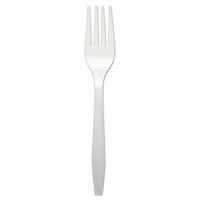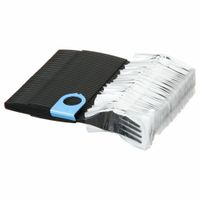Call +(254) 703 030 000 / 751 483 999 / 721 704 777
- Home
- Furnishings Appliances Hospitality
- Breakroom Food Service Disposables
- Disposable Cutlery
Frequently Asked Questions
What are the benefits of using disposable cutlery?
Disposable cutlery offers several benefits, particularly in terms of convenience, hygiene, and cost-effectiveness.
Firstly, convenience is a major advantage. Disposable cutlery is lightweight and easy to transport, making it ideal for outdoor events, picnics, and parties. It eliminates the need for washing, saving time and effort, especially in large gatherings or events where cleaning up can be cumbersome.
Hygiene is another significant benefit. Disposable cutlery is typically used once and then discarded, reducing the risk of cross-contamination and the spread of germs. This is particularly important in public settings or during outbreaks of contagious diseases, where maintaining high hygiene standards is crucial.
Cost-effectiveness is also a key benefit. Disposable cutlery is generally cheaper than purchasing and maintaining reusable cutlery. It eliminates the costs associated with washing, such as water, detergent, and labor, making it an economical choice for businesses like catering services and fast-food restaurants.
Additionally, disposable cutlery is available in a variety of materials, including biodegradable and compostable options, which can be more environmentally friendly than traditional plastic. These eco-friendly options help reduce the environmental impact and cater to the growing demand for sustainable products.
Finally, disposable cutlery offers versatility and variety. It comes in different designs, colors, and materials, allowing for customization to suit different themes and preferences. This makes it suitable for a wide range of occasions, from casual gatherings to formal events.
In summary, disposable cutlery provides practical benefits in terms of convenience, hygiene, cost, environmental considerations, and versatility, making it a popular choice for both personal and commercial use.
How does disposable cutlery help in reducing washing expenses?
Disposable cutlery helps reduce washing expenses by eliminating the need for water, detergent, and energy typically required for cleaning reusable utensils. When using disposable cutlery, businesses and households can significantly cut down on water consumption, which directly translates to lower water bills. Additionally, the absence of washing reduces the need for detergents and cleaning agents, further decreasing expenses related to purchasing these products.
Energy savings are another critical factor. Washing reusable cutlery often involves the use of dishwashers or hot water, both of which consume electricity or gas. By opting for disposable options, the energy costs associated with heating water and running dishwashers are eliminated. This can be particularly beneficial for large-scale operations like restaurants or catering services, where the volume of cutlery used is substantial.
Labor costs are also reduced with disposable cutlery. In settings where staff is employed to wash dishes, the time and effort saved by using disposables can be redirected towards other productive tasks, potentially reducing the need for additional staff or overtime pay. This can lead to significant savings in payroll expenses.
Moreover, disposable cutlery simplifies logistics and storage. Without the need for washing facilities, businesses can save on space and maintenance costs associated with dishwashing equipment. This can be especially advantageous in mobile or temporary setups, such as food trucks or outdoor events, where washing facilities may be limited or unavailable.
In summary, disposable cutlery offers a cost-effective alternative by minimizing water, detergent, energy, labor, and equipment expenses, making it an attractive option for both businesses and individuals looking to reduce their overall washing-related costs.
What materials are commonly used to make disposable cutlery?
Disposable cutlery is typically made from a variety of materials, each chosen for its cost-effectiveness, durability, and environmental impact. The most common materials include:
1. **Plastic**: The most prevalent material, often made from polystyrene or polypropylene. These plastics are lightweight, inexpensive, and can be molded into various shapes. However, they are not biodegradable and contribute significantly to environmental pollution.
2. **Bioplastics**: Derived from renewable sources like corn starch or sugarcane, bioplastics such as PLA (polylactic acid) are used as a more sustainable alternative to traditional plastics. They are compostable under industrial conditions but may not break down easily in natural environments.
3. **Wood**: Wooden cutlery, often made from birch or bamboo, is biodegradable and compostable. It is a popular eco-friendly option, though it can be more expensive than plastic.
4. **Bamboo**: A type of wood, bamboo is particularly sustainable due to its rapid growth rate. Bamboo cutlery is durable, biodegradable, and compostable, making it an environmentally friendly choice.
5. **Paper**: Some disposable cutlery is made from paper or cardboard, often coated with a thin layer of wax or plastic to improve durability and moisture resistance. These are generally biodegradable and compostable.
6. **Starch-based materials**: Made from potato, corn, or other plant starches, these materials are biodegradable and compostable. They offer a more sustainable alternative to traditional plastics.
7. **Metal-coated plastic**: Occasionally, disposable cutlery is made from plastic with a thin metal coating to enhance strength and appearance. These are less common due to higher costs and environmental concerns.
Each material has its advantages and drawbacks, influencing the choice based on factors like cost, environmental impact, and intended use.
How does disposable cutlery limit the spread of germs?
Disposable cutlery limits the spread of germs primarily by being single-use, which reduces the risk of cross-contamination. When cutlery is used only once, it eliminates the possibility of germs being transferred from one person to another through shared utensils. This is particularly important in public dining settings, such as restaurants, cafeterias, and events, where multiple people might otherwise use the same cutlery.
Additionally, disposable cutlery is typically manufactured, packaged, and sealed in a sterile environment, minimizing the initial exposure to germs. Once opened, it is used by a single individual and then discarded, preventing any further contact with others. This is in contrast to reusable cutlery, which requires thorough washing and sanitizing between uses to ensure it is free from germs. In situations where proper cleaning protocols are not strictly followed, reusable cutlery can become a vector for germ transmission.
Moreover, disposable cutlery is often made from materials that are less porous than some reusable options, reducing the likelihood of germs adhering to the surface. This characteristic further diminishes the potential for germ transfer.
In environments where hygiene is a top priority, such as hospitals or during outbreaks of infectious diseases, the use of disposable cutlery can be a critical measure in infection control. By ensuring that each person uses a fresh set of utensils, the risk of spreading germs through shared contact is significantly reduced, contributing to overall public health safety.
What are Dixie Ultra SmartStock dispensers?
Dixie Ultra SmartStock dispensers are advanced, hygienic cutlery dispensing systems designed for commercial and institutional settings such as restaurants, cafeterias, and food service operations. These dispensers are part of the Dixie Ultra product line, which is known for its durability and efficiency in managing disposable cutlery.
The SmartStock dispensers are engineered to improve operational efficiency and reduce waste by dispensing one piece of cutlery at a time. This feature not only minimizes the amount of cutlery used but also helps in maintaining a clean and organized serving area. The dispensers are available for different types of cutlery, including forks, knives, and spoons, and are designed to be easily interchangeable, allowing for flexibility in meeting various dining needs.
One of the key benefits of the Dixie Ultra SmartStock dispensers is their contribution to hygiene. By dispensing cutlery one piece at a time, they reduce the risk of cross-contamination, as users only touch the piece they take. This is particularly important in environments where food safety is a priority.
The dispensers are also designed for ease of use and maintenance. They are typically made from durable materials that withstand heavy use and are easy to clean. The refill process is straightforward, with cutlery refills available in pre-packaged cartridges that can be quickly loaded into the dispenser, minimizing downtime and labor costs.
Overall, Dixie Ultra SmartStock dispensers offer a practical solution for managing disposable cutlery in high-traffic food service environments, enhancing both operational efficiency and customer satisfaction through their innovative design and functionality.
Where can disposable cutlery be used effectively?
Disposable cutlery can be effectively used in various settings where convenience, hygiene, and ease of cleanup are priorities. These include:
1. **Outdoor Events and Picnics**: Disposable cutlery is ideal for outdoor gatherings such as picnics, barbecues, and festivals. It eliminates the need to transport and wash reusable utensils, making it convenient for both hosts and guests.
2. **Catering and Food Services**: In catering services, especially for large events like weddings or corporate functions, disposable cutlery simplifies logistics. It reduces the need for extensive cleanup and is often more cost-effective.
3. **Fast Food and Takeaway Restaurants**: These establishments benefit from disposable cutlery as it allows for quick service and easy disposal, aligning with the fast-paced nature of the business.
4. **Travel and Transportation**: On airplanes, trains, and buses, disposable cutlery is used to serve meals efficiently while maintaining hygiene standards. It is lightweight and easy to manage in confined spaces.
5. **Emergency and Relief Situations**: In disaster relief operations or emergency shelters, disposable cutlery is crucial for distributing meals quickly and safely to large numbers of people without the need for washing facilities.
6. **Schools and Institutions**: In school cafeterias or institutional settings, disposable cutlery can help manage large volumes of students or attendees, ensuring quick service and reducing the risk of cross-contamination.
7. **Healthcare Facilities**: Hospitals and care homes use disposable cutlery to maintain high hygiene standards and prevent the spread of infections, especially in areas with vulnerable populations.
8. **Camping and Hiking**: For campers and hikers, disposable cutlery is a practical choice due to its lightweight nature and the ease of disposal, minimizing the need to carry extra weight.
In all these scenarios, the use of biodegradable or compostable disposable cutlery is encouraged to minimize environmental impact.
How should bulk disposable cutlery be stored or dispensed?
Bulk disposable cutlery should be stored and dispensed in a manner that ensures hygiene, accessibility, and organization. First, store the cutlery in a clean, dry, and cool environment to prevent contamination and degradation. Use sealed containers or original packaging to protect them from dust, moisture, and pests. Label the containers clearly to identify the type of cutlery and the quantity inside.
For dispensing, consider using a cutlery dispenser or organizer. These devices are designed to dispense one piece at a time, reducing waste and minimizing contact with other pieces, which helps maintain hygiene. Place the dispenser in a convenient location, such as near the serving area or at the end of a buffet line, to ensure easy access for users.
If a dispenser is not available, arrange the cutlery in trays or bins with dividers to separate different types (forks, knives, spoons). Ensure that the handles are facing outward to allow users to pick them up without touching the eating end. Regularly monitor and refill the dispensers or trays to ensure a constant supply.
Implement a first-in, first-out (FIFO) system to use older stock first, reducing the risk of using expired or compromised cutlery. Train staff on proper handling and replenishing procedures to maintain cleanliness and orderliness.
Finally, consider the environmental impact of disposable cutlery. Opt for biodegradable or compostable options when possible, and provide clearly marked disposal bins for recycling or composting to encourage responsible disposal by users.

